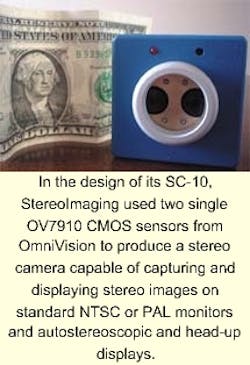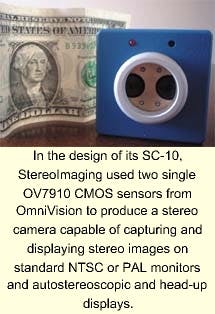Stereo imaging camera targets microscopy applications
Most stereo video cameras are two monocular cameras bolted together. Using dual monocular cameras, multiplexers, frame grabbers, and PCs, stereo imaging systems use the principle of triangulation to determine an object computed in image space on the host PC. These systems are inherently large and expensive because they use off-the-shelf components not designed for this purpose. To overcome these drawbacks, start-up StereoImaging (Tyngsboro, MA) has developed the SC-10 stereo camera in the size of a single camera housing that is capable of capturing and displaying stereo images on standard NTSC or PAL monitors, as well as on autostereoscopic and head-up displays. The camera is based around two OV7910 CMOS sensors from OmniVision Technologies (Sunnyvale, CA). Sensor resolution is 510 x 492 pixels in NTSC format and 628 x 582 pixels in PAL format.
In operation, light is first collimated and focused using a custom-built lens onto a printed-circuit board (PCB) that carries the two CMOS imagers. This allows an image to be obtained from two different perspectives. According to Philip McKinley, president of StereoImaging, the use of CCD devices was prohibitive in this application because the multiple power-support circuitry would not have allowed the camera to be designed in a 3.4 x 2.13 x 2.13-in. footprint. "Although CCD devices can exhibit greater sensitivity and dynamic range," McKinley says, "this is not as an important factor in applications such as stereomicroscopy, so CMOS devices are sufficient." After images are captured by the CMOS sensors, they can be displayed either as 60-Hz field-sequential interlaced NTSC images or as 60-Hz noninterlaced images on autostereoscopic or head-up displays.
To display images on standard NTSC monitors, images from each sensor are field-sequentially multiplexed to provide a standard NTSC output. Field-sequential video techniques use time principles to separate the two eye views. To view the images, the user wears a pair of NuVision 60GX IR synchronized glasses from MacNaughton (Beaverton, OR) to block the left eye from seeing the screen while the right eye view is displayed. To display the 3-D image in real-time, the fields are then successively switched at 30 Hz per field.
Unfortunately this interlacing can cause an unacceptable level of flicker. To overcome this, StereoImaging has designed the SC-10 camera with dual left and right output channels in NTSC or PAL format. As a result, the camera can directly interface to autostereographic displays such as the 2015XLT, a 1024 x 768-pixel, 15.1-in. 3-D LCD display from Dimension Technologies (Rochester, NY), and the iGlasses head-up display from I/O Display (Menlo Park, CA). Commercially available interface systems (from 3DTV, StereoGraphics, and others) will allow flicker-free viewing at 120 Hz with synchronized glasses.
At a recent demonstration, all three types of displays were shown imaging a PCB. Whereas the NTSC display showed perceptible flicker, the 2015XL showed none. However, due to the lenticular design of the LCD display, brightness was somewhat reduced. Using the iGlasses proved effective with 3-D images appearing bright and sharp. Says Luis Figarella, vice president of business development at StereoImaging, "stereo imaging is proving effective in microscopy, small-component inspection, and remote object observation." Already, TV Ferret (Burnt Hills, NY) has shown the camera in use in a pipe-inspection system, where it was necessary to remotely monitor hundreds of feet of an 8-in.-diameter pipe. This application was performed with the SC-WA—a wide-angle version of the SC-10 stereo camera.

